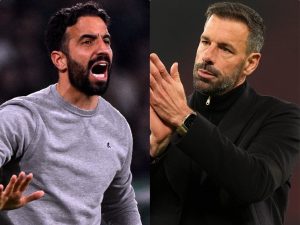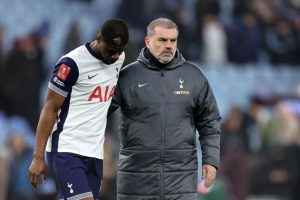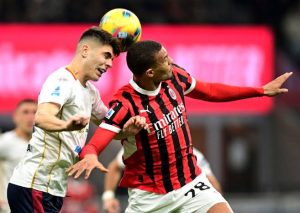14 JANUARY 2024, PREMIER LEAGUE
United Manchester 2
Spurs 2 Højlund (3) Tottenham Hotspur 2
Rashford, 40.
Richarlison (19) Bentancur (46).
In order to split the points with fellow top-four contender Manchester United, Tottenham overcame a two-fold deficit at Old Trafford. Sir Jim Ratcliffe, the team’s new co-owner, saw the home team play. He saw a physical match in which both teams were happy to win a point but disappointed not to take three.
The home team started the game with a sharp counterattack, which was capped off by Pierre-Emile Højlund’s close-range goal. Subsequently, Richarlison scored Tottenham’s first equaliser by heading home a Pedro Porro corner.
In his 14th game and on his 32nd attempt of the home campaign, Marcus Rashford scored his first goal at Old Trafford this season to give United a 2-1 lead at the break. It did not last long, as Rodrigo Bentancur’s finish seconds after the second half began saw Tottenham respond.
Although Tottenham was clearly the better team throughout the game, United replacement Scott McTominay lost a fantastic opportunity to win the match in extra time.
The managers’ perspective
“We were encouraging to see how we broke the lines, how direct we were, and how we finished,” Erik ten Hag stated after his team scored two excellent goals in the first half. With the exception of the set plays, I’m quite pleased with the defending. We didn’t play great set play defence. We give them a diagonal pass because we are aware of their rapid releases. They can’t break our entire team with a single diagonal pass.
Ange Postecoglou declared, “We played some great stuff, scored a couple of goals, probably unlucky not to win the game.” “They are a good team in transition; their front four is among the best in the league, but again, the way we handled that and responded to that—to be fair, it’s been like that all year—we got smacked on the transition a few of times. When we’ve had to deal with something similar, the guys have never let up, and they didn’t today either.
Our UEFA-licensed tactical specialists have highlighted some of the game’s most important themes below.
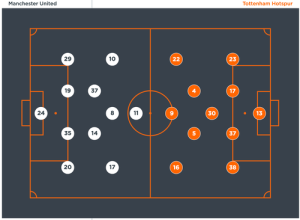
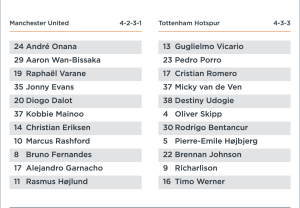
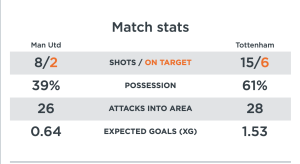
Manchester United went with a 4-2-3-1 shape, against Tottenham’s 4-3-3 framework. Whenever feasible, United tried to attack through their wingers, looking for Rashford on the left (see below). With Aaron Wan-Bissaka’s help, he drove at Porro nonstop. This was presumably done to counter Brennan Johnson’s threat of dribbling in a one-on-one situation rather than to gain an offensive edge.

Alejandro Garnacho held the width on United’s right as well, assisted by more daring overlapping runs from Diogo Dalot. The home team attacked Tottenham’s block with wide pairs.
Spurs attempted to create one-on-one opportunities by attacking wide through their wingers. Full-backs Porro and Destiny Udogie shifted into the midfield, frequently bringing Garnacho and Rashford, their direct opponents, with them (see below). This gave Johnson and Timo Werner more room to attack their immediate opponent, the full-back, and it also put United’s wingers in much busier situations whenever the home team got the ball back within their own half. Spurs so limited some of United’s deeper counterattacking options.
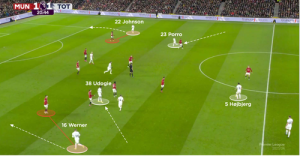
In the first twenty minutes, both teams forced seven corners between them, with their wingers seeing a lot of action. Just before halftime, Spurs hit the crossbar after equalising from one.
Compared to Ten Hag’s squad, Postecoglou’s group possessed the ball for significantly longer stretches of time and continuously held superior attacking territory. Nevertheless, United’s high and expansive front three continued to offer a threat in the event of a recapture. The higher they recovered possession, the greater the threat. Rashford was especially good at taking advantage of the space past Porro, grabbing hold of passes and directing them through or over the right-back. Bruno Fernandes would frequently rotate with Christian Eriksen (below), going deeper at this point.
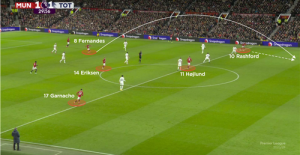
Rashford’s cool, twisting goal gave United the lead back in the first half, but their haste to locate wingers quickly and directly wasn’t always successful. When Porro and Udogie were healing from injuries and weren’t able to take advantage of Spurs’ full-backs, United gave up possession far too easily. Tottenham’s control of the ball and offensive territory was aided by this.
Influential full-backs for Tottenham
The first half saw Spurs’ narrow full-backs encouraging United counterattacks, but the first few minutes of the second half demonstrated the advantages of pressing them inside. After the half, United upped their high pressing, drawing the midfielders to Udogie and Porro since their wingers jumped higher. Spurs’ central midfielders discovered important spaces below.

United’s defence four were pinned by the forward three, further overwhelming the midfield. The visitors advanced deliberately as soon as the Spurs back line made a connection. especially after Bentancur tied the score early in the second half.
After that, Tottenham’s starting number eights moved wide to receive from the centre backs, frequently pulling their markers with them. Porro and Udogie, on the other hand, worked virtually nonstop in the inside channel. They made runs forward to receive past United’s back line, but they also received between the lines to link into the front three (below).
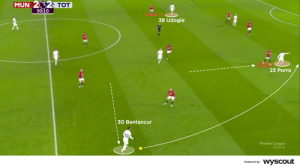
After Bentancur’s score, United’s wingers paid more attention to these actions. As a result, except from sporadic attacking bursts when the ball was thrown towards Rashford, the home team’s counterattacking style virtually vanished.
Throughout the second half, Tottenham maintained their control over territory and possession thanks to the indispensability of Udogie and Porro in the inner channels. Porro and Udogie played as number eights whenever the front line produced forward runs. Working deftly off United’s midfield unit’s shoulders, they received either side of Richarlison, leaving the hosts’ wingers unable to block access into them (below).
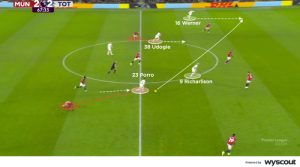
Still, Tottenham failed to find a game-winning third despite making nearly twice as many attempts as United.
Visit CV Academy to find out more from The Coaches’ Voice’s certified coaches.
Writer: The Voice of the Coaches
